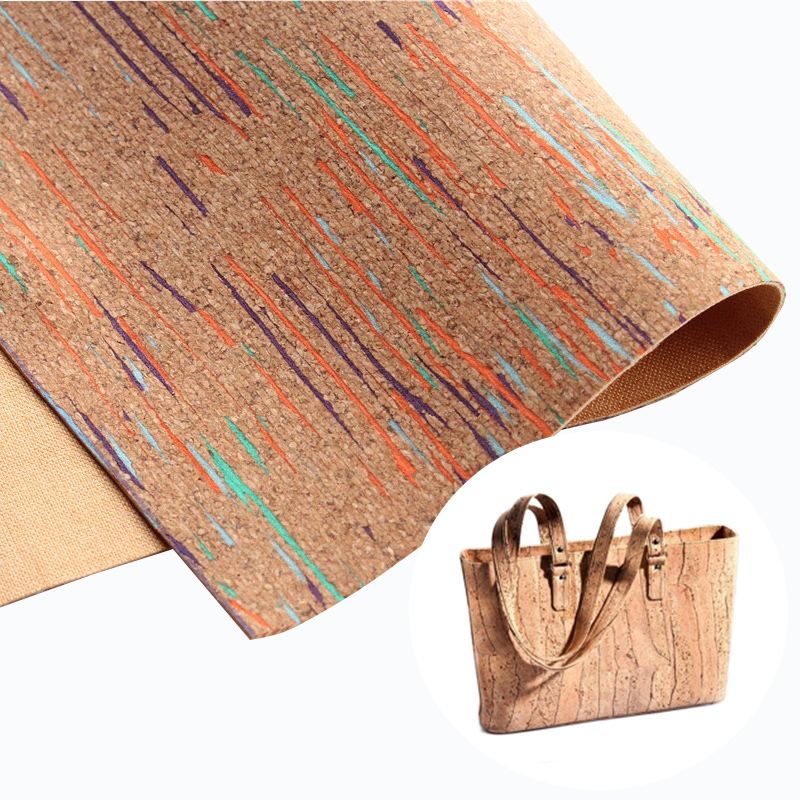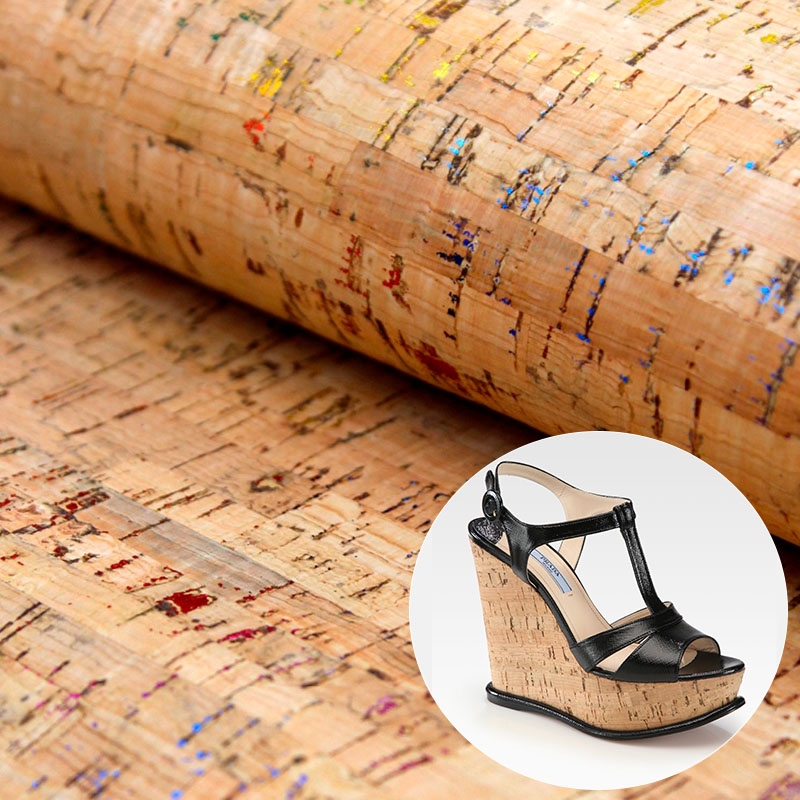Cork Fabric
-

Glossy Vivid Vintage Cork Leather Portugal Leather Velvet Backing for Making Yoga Mat Notebook Cover Accessories
Cork leather is a leather substitute made from the bark of the cork oak tree. Cork, also known as cork or cork, comes primarily from the outer bark of the Mediterranean oak tree, usually the bark of the deciduous tree Quercus variabilis of the Fagaceae family.
The production process of cork leather includes the following steps: Harvesting: The bark is usually harvested every 9 years and air-dried for six months. Processing: The bark is boiled and steamed to give it extra elasticity. Forming: Heat and pressure are used to form blocks, which can then be cut into thin layers to form a leather-like material, depending on the application. Cork leather has the following properties: Completely natural: Cork is a completely natural, easily recyclable product, typically made from cork oak trees. Sustainability: Cork oak trees are harvested every nine years and have a lifespan of more than 200 years, making cork a sustainable material. Environmentally friendly: Cork does not need to be replanted after harvesting, and its production process has a low impact on the environment. Physical properties: Cork leather is waterproof, highly durable, lightweight, and easy to maintain, making it a great choice for footwear and fashion accessories. As one of the more mature “vegan leathers” on the market, cork leather has been adopted by many fashion brands, including Calvin Klein, Prada, Stella McCartney, Louboutin, Michael Kors, and Gucci. These brands mainly use cork leather to make products such as handbags and shoes. In addition, many new products have appeared on the market, such as watches, yoga mats, and wall decorations. -

Eco friendly Natural Bio-based Coffee Grounds Portugal Cork Sheet Leather Fabric Microfiber Base For Bag Shoes Notebook
With the rise of sustainability and eco-friendly products, cork fabric is becoming a popular choice in many industries.
-

Factory wholesale stock avariety of patterns Pu Real Cork Synthetic Leather natural cork fabric leather waterproof fabric
Unlike traditional fabrics, cork fabrics offer exceptional strength and abrasion resistance, making them perfect for long-lasting creations
-

Eco-friendly Synthetic Cork Leather Upholstery Fabric For Handbags Furniture
Sewing enthusiasts will be delighted to discover the endless possibilities that cork fabric presents.
-

Eco Vegan Wood Material Faux Upholstery Decorative Cork Synthetic Leather Fabric Pu Synthetic Leather For Lady Shoes Lining Handbags Shoe Footwear
Cork fabric is as durable as leather, has the same touch pro quality. It comes from bark of cork oak tree.
-

Vintage coffee stripes 0.4mm natural cork leather for cork tote handbags shoes belts tiles cups planters
Natural cork fabric with sustainable backing, organic cotton, bamboo fiber, soy fiber, linen, etc. It is a truly vegan fabric.
- Soft to the touch and pleasant to view.
- Natural color without AZO dye, basic and cheapest.
- Easily cleaned and long lasting.
- Durable as leather, versatile as fabric.
- Waterproof and washable.
- Dust, dirt, and grease repellent.
- Handbags, upholstery, re-upholstery, shoes & sandals, pillowcases and unlimited other uses.
- Material: Cork fabric + PU or TC backing
Backing: PU leather (0.6MM), microfiber, TC fabric(63% cotton 37% polyester), 100% cotton, linen, recycled TC fabric, soybean fabric, organic cotton, Tencel silk, bamboo fabric. - Our manufacturing process allows us to work with different backings.
- Pattern: huge color selection
Width:52″
Thickness:0.8MM( PU backing), 0.4-0.5mm(TC fabric backing). - wholesale cork fabric by the yard or meter, 50 yards per roll. Directly from the original manufacturer based in China with competitive price,low minimum,custom colors
-

Eco friendly vegan Natural BIO-BASED Coffee Grounds Pattern Marketable Bark Grain Portugal Natural Cork Colored Pu Cork sheet Leather Fabric material for handbags/wallet /shoes/ bags/ yoga mat
Coffee Cork Fabric launched a coffee powder and cork can be composed of new products – coffee cork fabric, while having the advantages of coffee grounds fiber and cork.
- Cork: has very good elasticity, sealing, heat insulation, sound insulation, electrical insulation and friction resistance, coupled with non-toxic, tasteless, small specific gravity, soft to the touch, not easy to catch fire and other advantages, there is still no artificial products comparable to it.
- Coffee grounds: environmentally friendly, deodorizing, fast drying, UV resistant and have many different advantages. The overall life cycle of the coffee industry is enhanced by recycling coffee grounds to make them more valuable.
- Material: Cork + Coffee grounds + fabric backing
- Backing: PU faux leather (0.6mm) or TC fabric(0.25mm, 63% cotton 37% polyester), 100% cotton, linen, recycled TC fabric, soybean fabric, organic cotton, Tencel silk, bamboo fabric.
- Our manufacturing process allows us to work with different backings.
- Pattern: Natural & Coffee
Width:52″
Thickness:0.8-0.9mm(PU backing) or 0.5mm(TC fabric backing). - wholesale cork fabric by the yard or meter, 50yards per roll.
- Directly from the original manufacturer based in China with competitive price,low minimum, custom colors
-

Wholesale Wood Grain Faux Eco Leather Fabric Sheet Cork Fabric /Roll for Making Bag/Shoe/Craft/Decorative
Colored cork fabric with natural dyes that will not fade. The colorful cork fabric is suitable for making various beautiful bags.
- Soft to the touch and pleasant to view.
- Environmentally friendly and ecologically fabric.
- Gift for fabric lovers, and DIY crafts lovers.
- Durable as leather, versatile as fabric.
- Waterproof and stain-resistant.
- Dust, dirt, and grease repellent.
- Handbags, upholstery, re-upholstery, shoes & sandals, pillowcases and unlimited other uses.
- Material: Cork fabric + TC backing
- Backing: TC fabric(63% cotton 37% polyester), 100% cotton, linen, recycled TC fabric, soybean fabric, organic cotton, Tencel silk, bamboo fabric.
- Our manufacturing process allows us to work with different backings.
- Pattern: huge color selection
Width:52″ - Thickness:0.4-0.5 mm(TC fabric backing).
- wholesale cork fabric by the yard or meter, 50 yards per roll. Directly from the original manufacturer based in China with competitive price, low minimum, custom colors
-

Printing flower faux synthetic vegan cork leather for making DIY craft handmade purses pouch wallet handbags
Original Manufacturer Of Cork Fabric & Vegan Leather Bags
As a factory direct wholesale cork fabric manufacturer & cork bag supplier for over 20 years. We aim to develop environmentally friendly, healthy, and safe cork fabrics and aim to provide the best quality vegan bags.
- 100% Natural FSC Certified Cork Raw Material
- Over 500 Cork Fabric Patterns
- Vegan Eco-Friendly Backing
- Ultimate Quality Comparable To Leather
- Full production capabilities that you can rely upon
- Best Quality Standards
- The best and most competitive price
- Fast sample turnaround time
-

Portugal real wood design bread veins recycled bag wallet vegan PU natural cork leather fabric Soft Wood Cork Embossed Faux Synthetic Leather Fabric for Making Upholstery Bags Decorative
Cork leather is derived from oak bark, an innovative and eco-friendly leather fabric that feels comfortable to the touch as if it were leather.
- Touch pro quality and Unique outlook.
- Cruelty-free, PETA applied, 100% animal-free vegan leather.
- easy to maintain and long-lasting.
- Durable as leather, versatile as fabric.
- Waterproof and stain resistant.
- Dust, dirt, and grease repellent.
- AZO-free dye,no color fading issue
- Widely used on Handbags, upholstery, re-upholstery, shoes & sandals, pillow cases and unlimited other uses.
- Material: Cork leather sheets + fabric backing
- Backing: PU faux leather (0.6mm) or TC fabric(0.25mm, 63% cotton 37% polyester), 100% cotton, linen, recycled TC fabric, soybean fabric, organic cotton, Tencel silk, bamboo fabric.
- Our manufacturing process allows us to work with different backings.
- Pattern: huge color selection
Width:52″
Thickness:0.8-0.9mm(PU backing) or 0.5mm(TC fabric backing). - wholesale cork fabric by the yard or meter, 50yards per roll.
- Directly from the original manufacturer based in China with competitive price,low minimum, custom colors
-

Eco-Friendly Natural Cork Digital Printed Pu Leather Fabric for Bags, Shoes, Wallets,Sandals
- Natural and sustainable fabric, obtained from the bark of cork oak tree.
- The cork bark can regenerate back in 8-9 years.
- Versatile printing pattern available, same as fabric.
- Waterproof and stain-resistant.
- Dust, dirt, and grease repellent.
- Good choice for fashion Handbags, fabric lovers, DIY crafts, sewing with cork lovers.
- Material: Cork fabric + TC backing
Backing: TC fabric(63% cotton 37% polyester), 100% cotton, linen, recycled TC fabric, soybean fabric, organic cotton, Tencel silk, bamboo fabric. - Our manufacturing process allows us to work with different backings.
- Pattern: huge color selection
Width:52″
Thickness:0.4-0.5mm(TC fabric backing).
wholesale cork fabric by the yard or meter, 50 yards per roll. Directly from the original manufacturer based in China with competitive price,low minimum,custom colors
-

best selling pu cork fabric leather for decorate wall and floor book cover mat cork
Our quilted cork fabrics combine modern techniques and natural materials, which are not only environmentally friendly and durable, but also have various pattern processes. Such as laser, embossing, patchwork, etc.
- Different colors and patterns quilted cork fabric.
- Environmentally friendly and ecologically fabric from plant-based bark of cork oak tree.
- Easily cleaned and long-lasting.
- Waterproof and stain-resistant.
- Dust, dirt, and grease repellent.
- Moisture-resistant and germ-free.
- Good fabric for handmade bags, upholstery wallpaper, shoes & sandals, pillowcases and unlimited other uses.
- Material: Cork fabric + TC backing (63% cotton 37% polyester), 100% cotton, linen, recycled TC fabric, soybean fabric, organic cotton, Tencel silk, bamboo fabric.
Our manufacturing process allows us to work with different backings.
- Pattern: quilted pattern, splicing weaving pattern, laser pattern, embossed pattern.
- Size: Width:52″
Thickness: 0.4-0.5mm(TC fabric backing). - Directly from the original manufacturer based in China with competitive price,low minimum, custom colors.







